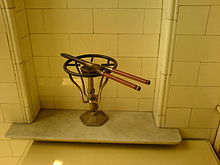Hair iron: Difference between revisions
added sabino |
m →Hair iron brands: rv |
||
| Line 50: | Line 50: | ||
*[[Toni & Guy]] |
*[[Toni & Guy]] |
||
*[[Wella]] |
*[[Wella]] |
||
nicky clarke |
|||
==See also== |
==See also== |
||
Revision as of 16:08, 5 January 2008

A hair iron or hair tong is a tool used to change the structure of the hair with the help of heat. There are two general kinds: Straightening irons, used to straighten the hair, and curling irons, used to make the hair curly. Straightening irons may also be called flat irons, but not to be confused with clothes flat irons. There are also irons, called styling irons, that can be used to both straighten and curl the hair. One tool means that you can straighten one portion of the strand and curl the other.
Hair straightening
History
Hair straighteners work by breaking down the hair's hydrogen bonds found in the hair's cortex, which cause hair to bend and become curly. Once the bonds are broken, hair is prevented from holding its original, natural form, though the hydrogen bonds can re-form if exposed to moisture. [1]
In 1872, Marcel Grateau (a Parisian) used heated rods to straighten or style hair.[2]
Ian Gutgold used harsh chemicals in lotions applied to the hair and scalp to straighten hair, however, these preparations often led to scorched scalps and damaged hair.
Simon E. Monroe patented a hair straightener in 1906 that comprised metallic teeth that are combed through the hair,[3] while in 1909 Issac K. Shero patented a hair straightener composed of two flat irons that are heated and pressed together.[4]
Years later, Sharrell invented heated metal hair-care implements, such as hot combs. The hot metal straightener slid easily through the hair, causing less damage and dryness than previously-used techniques. Later, ceramic and electrical straighteners were introduced, allowing for adjustment of heat settings and straightener size.
Another method of hair straightening is the thermal Japanese hair straightening technique, which acts as a sort of "anti-perm". It is now available at many salons but is quite expensive and must be repeated on a regular basis.
Modern flat irons
High-end modern hair straighteners have ceramic heating elements, which cause less damage to hair, are more effective and heat up faster than non-ceramic coated heating plates. Less expensive brands usually do not have ceramic heating elements though some may have a paint-like coating that gives the appearance of ceramic plating.
Many high end straighteners claim to use ionic and infra red technology, which claims to seal in moisture and oils and to reduce static and frizz.
Depending on the hair type, repeated use of hair straighteners, like most other heat styling tools, can cause varying amounts of damage such as split ends, thinning of the hair shaft and even causing hair to become brittle and prone to breakage. Generally, after extensive damage, hair will show signs of dryness and display an unhealthy appearance. However, many companies, such as L’Oréal and Tresemmé, have began to manufacture heat protection sprays and cream which aim to reduce the amount of damage that is caused by the use of straighteners.
Hair straighteners should only be used on dry hair, unless they are specially made with vents to let the moisture out. These sort of irons are usually called "Wet Dry" irons.
Based on the materials used in the heating plates, hair irons can be classified as ceramic, tourmaline and traditional metal flat iron. Ceramic hair irons are believed to be gentle to the hair.
Hair curling
Hair curling may be achieved through heated rollers, heated irons, steam-heated curlers, or by a perm. Modern curling irons are made of elements similar to that of straightening.
Hair crimping
Hair crimping is a form of hair curling, where the hair is crimped into smaller curls with the use of a sawtooth iron.
Hair iron brands
See also
External links
- "Hair Straightener - LoveToKnow Hair".
- Melissa B. Read. "Designing a better hair straightener" (PDF).
Understanding the problem: What makes hair straight?
- "Hair Straightener".
- "Sabino Hair Solutions for fighting frizz".
- ^ Read, Melissa B. "Designing a Better Hair Straightener." MIT, . [1]
- ^ http://www.paralumun.com/hairst.htm
- ^ Hair Straightener Patent Number 819444
- ^ Hair Straightener Patent Number
